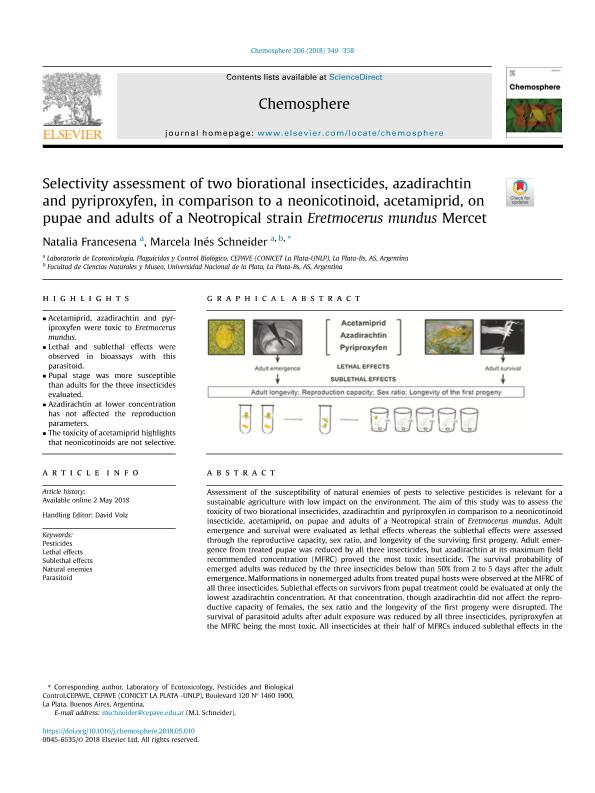Mostrar el registro sencillo del ítem
dc.contributor.author
Francesena, Natalia

dc.contributor.author
Schneider, Marcela Inés

dc.date.available
2019-10-22T12:37:06Z
dc.date.issued
2018-09
dc.identifier.citation
Francesena, Natalia; Schneider, Marcela Inés; Selectivity assessment of two biorational insecticides, azadirachtin and pyriproxyfen, in comparison to a neonicotinoid, acetamiprid, on pupae and adults of a Neotropical strain Eretmocerus mundus Mercet; Pergamon-Elsevier Science Ltd; Chemosphere; 206; 9-2018; 349-358
dc.identifier.issn
0045-6535
dc.identifier.uri
http://hdl.handle.net/11336/86810
dc.description.abstract
Assessment of the susceptibility of natural enemies of pests to selective pesticides is relevant for a sustainable agriculture with low impact on the environment. The aim of this study was to assess the toxicity of two biorational insecticides, azadirachtin and pyriproxyfen in comparison to a neonicotinoid insecticide, acetamiprid, on pupae and adults of a Neotropical strain of Eretmocerus mundus. Adult emergence and survival were evaluated as lethal effects whereas the sublethal effects were assessed through the reproductive capacity, sex ratio, and longevity of the surviving first progeny. Adult emergence from treated pupae was reduced by all three insecticides, but azadirachtin at its maximum field recommended concentration (MFRC) proved the most toxic insecticide. The survival probability of emerged adults was reduced by the three insecticides below than 50% from 2 to 5 days after the adult emergence. Malformations in nonemerged adults from treated pupal hosts were observed at the MFRC of all three insecticides. Sublethal effects on survivors from pupal treatment could be evaluated at only the lowest azadirachtin concentration. At that concentration, though azadirachtin did not affect the reproductive capacity of females, the sex ratio and the longevity of the first progeny were disrupted. The survival of parasitoid adults after adult exposure was reduced by all three insecticides, pyriproxyfen at the MFRC being the most toxic. All insecticides at their half of MFRCs induced sublethal effects in the survivors’ adults, with pyriproxyfen being the most harmful to the reproductive capacity of females. In conclusion, both biorational insecticides were toxic to E. mundus.
dc.format
application/pdf
dc.language.iso
eng
dc.publisher
Pergamon-Elsevier Science Ltd

dc.rights
info:eu-repo/semantics/openAccess
dc.rights.uri
https://creativecommons.org/licenses/by-nc-sa/2.5/ar/
dc.subject
LETHAL EFFECTS
dc.subject
NATURAL ENEMIES
dc.subject
PARASITOID
dc.subject
PESTICIDES
dc.subject
SUBLETHAL EFFECTS
dc.subject.classification
Otras Ciencias Agrícolas

dc.subject.classification
Otras Ciencias Agrícolas

dc.subject.classification
CIENCIAS AGRÍCOLAS

dc.title
Selectivity assessment of two biorational insecticides, azadirachtin and pyriproxyfen, in comparison to a neonicotinoid, acetamiprid, on pupae and adults of a Neotropical strain Eretmocerus mundus Mercet
dc.type
info:eu-repo/semantics/article
dc.type
info:ar-repo/semantics/artículo
dc.type
info:eu-repo/semantics/publishedVersion
dc.date.updated
2019-10-17T14:02:13Z
dc.journal.volume
206
dc.journal.pagination
349-358
dc.journal.pais
Estados Unidos

dc.journal.ciudad
Amsterdam
dc.description.fil
Fil: Francesena, Natalia. Consejo Nacional de Investigaciones Científicas y Técnicas. Centro Científico Tecnológico Conicet - La Plata. Centro de Estudios Parasitológicos y de Vectores. Universidad Nacional de La Plata. Facultad de Ciencias Naturales y Museo. Centro de Estudios Parasitológicos y de Vectores; Argentina
dc.description.fil
Fil: Schneider, Marcela Inés. Consejo Nacional de Investigaciones Científicas y Técnicas. Centro Científico Tecnológico Conicet - La Plata. Centro de Estudios Parasitológicos y de Vectores. Universidad Nacional de La Plata. Facultad de Ciencias Naturales y Museo. Centro de Estudios Parasitológicos y de Vectores; Argentina
dc.journal.title
Chemosphere

dc.relation.alternativeid
info:eu-repo/semantics/altIdentifier/doi/http://dx.doi.org/10.1016/j.chemosphere.2018.05.010
dc.relation.alternativeid
info:eu-repo/semantics/altIdentifier/url/https://www.sciencedirect.com/science/article/pii/S004565351830852X?via%3Dihub
Archivos asociados
